The southeastern Gulf of St. Lawrence was home to nearly half of the North Atlantic right whale population this summer, i.e. about 190 individuals. This estimate was obtained using aerial surveys and photo-identification campaigns. This is likely the largest concentration of right whales for the summer, according to Jean Landry, director of marine mammal science at Fisheries and Oceans Canada.
Experts from the National Oceanic and Atmospheric Agency (NOAA) identified 135 individuals in 2018, compared to 114 in 2017. However, census efforts were more intense in 2018. Some individuals were observed only once, while others were seen throughout the two-month photo-ID campaign. The animals’ movements also vary: some roamed up to 50 km in a single day while others were always photographed in the same area.
Acoustic surveys detected the first right whale in late April – as was the case in 2017 – and have still been locating individuals in recent days.
In the past, right whale sightings in the Gulf of St. Lawrence were anecdotal. They were more commonly found in summer in the Bay of Fundy and Roseway Basin. In an attempt to explain the increased presence of this species in the Gulf, special attention was paid to their favourite prey: copepods (tiny crustaceans). Data show a decrease in the presence of copepods in the right whale’s critical habitat. This decline has also been observed in the Gulf, but to a lesser extent. The Gulf still contains sufficient copepod biomass to meet the energy needs of right whales. Other areas with similar quantities of copepods have been found, so right whale monitoring may be conducted at these locations in the future.
These findings were reported by Fisheries and Oceans Canada researchers during a technical briefing. They presented the results of discussions of roughly forty experts from Fisheries and Oceans Canada, NOAA, universities and independent research groups. They met last week in Montréal to bring North Atlantic right whale knowledge up to date. Together, they studied 17 scientific articles and attempted to answer 20 questions. An advisory report written by consensus will be published shortly and will be available to the public.
The North Atlantic right whale population is declining, and there has also been a downward trend in the species’ breeding rate since 2010. Today’s population is estimated to be 411 individuals. Following a dramatic season in 2017 when 18 individuals perished and several were found entangled in fishing gear, strict protection measures were introduced in Canadian waters. In 2018, no deaths and three entanglements were reported in Canada. Measures including speed restrictions and fishing zone closures appear to have been beneficial to the species.
A meeting will be held in January to plan the protection measures to be implemented in 2019.
To read the complete Dossier : Right whales: the situation in 2018






